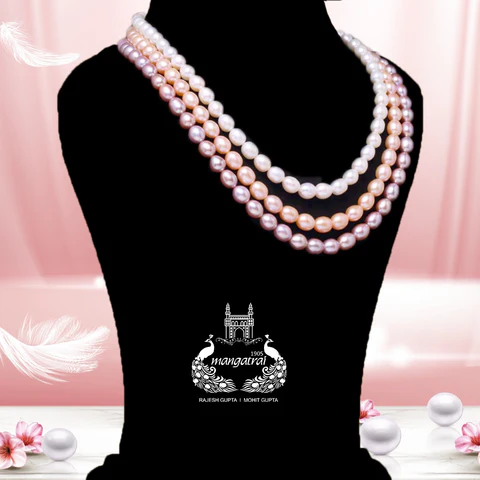The intricate and rich tapestry of culture and traditions in Hyderabad is incomplete without the mention of pearls. The luster and lucidity of pearls have found their way to the top of the charts in the country and around the globe, too. Pearls from Hyderabad and the craftsmanship that weaves them into traditional and stunning designs is a matter of pride. The time capsule in this place has preserved the sanctity and glory of the designs. The craftsmanship is a legacy handed down to the next generation and keeping the customs.
Pearls of Hyderabad – The Beginning
The 16th century was when Qutb Shahis began his rule, and the city of Golconda was born. As the town prospered, the affluent society demanded lavish pieces. Pearls were imported from Basra in the Gulf to Hyderabad, and the artisans crafted one masterpiece after the other to do justice to the ethereal gems. The designs were specially curated to flaunt pearl radiance and fit royalty’s needs.
Pearls are also called the “Queen of Gems,” and they are indeed the gems of Queens. The fame of Hyderabadi pearls has made its way to the state’s tourist attractions list. The history of Hyderabadi jewels and alluring jewellery goes back to the Persians who brought the precious gems to the place. As the decades went by, the incorporation of pearls and gems in the jewellery pieces of Nizams also became popular. They encouraged boosting the pearl trade and brought pearls to every luxurious aspect of their lives.
While crushed pearls on robes and stitched pearls on clothes were famous, the luminescent pearl necklace was a favorite. Pearls were also ground into fine powder and added to skincare routines for a glow.
Presence of Pearls in the Indian History
Contrary to popular belief, Hyderabadi pearls were the ones that just sensationalized the pearl jewelry. However, pearls have been around in India for centuries. They are a part of “Navratna,” or the nine gems. They have been used in medicines, food, and drink. They have been a part of Hindu traditions and mythology as well.
The era of Golconda before the nizams arrived is complete with records of wealth, robust trade, and political importance. One of the gates of Golconda is called Mochi Darwaza, which refers to the beginning of a pearl market. While many hotspots in India produced and dealt with pearls, Hyderabad is the most respected one as it did not decline in the Mughal age, unlike others. The Nizams immediately replaced the Qutub Shahs.
Traditional Pearls and Artistry
Nizams were probably the most prominent collectors of pearls in India. Their passion led them to acquire large quantities of pearls and store them in that treasury. Apart from the
quintessential Hyderabadi pearl jewellery, they were used in almost all of their pieces of jewellery. Irrespective of the gemstones, used pearls always accompanied them.
It is believed that pearls came into the city of Mumbai and were then transported to Hyderabad. However, a little village outside Hyderabad called Chandanpet was where pearls were sent for finishing. They pored, and holes were made to make them conducive for jewelry making. Over time, craftsmen moved to Hyderabad and gained experience working with pearls. Their expertise led them to create designs for the royal families. Their skill was respected, and the creations of Hyderabadi pearl jewellery became sought-after.
Popular Traditional Pearl Jewellery from Hyderabad
Here are some traditional pearl jewellery pieces that have been around for centuries and have evolved with time to fit the needs of modern wearers.
1. Satlada – A necklace that has 7 layers of pearl necklaces and is truly fit for a queen. It is a popular choice for brides or is generally worn only on special occasions.
2. Panchlada – A necklace similar to Satlada but with five layers. The Panchlada has the same air of opulence but can be worn for simpler events.
3. Chandbali – The muse of many songs and a traditional design with global appeal. A chandbali is a heavy, round-shaped earring adorned with pearls.
4. Kamarbandh – A traditional waistband that can have eclectic designs. A kamarbandh is a popular jewellery choice for brides. It can range from a simple pearl strand to a complex design.
5. Guttupusalu – The term “Guttapusalu” translates to “cluster of pearls” in the local language. This necklace has a gold stand with clusters of pearls attached to it that hang delicately.
6. Polki and Kundan – While these designs of jewellery focus on the use of precious metals and gemstones, they are incomplete without the presence of pearls.
In the last 10 to 15 years, we have seen a drift away from the grandeur of pearl jewellery. However, pearls have been around for centuries, and their coveted shine is a testament to their timeless elegance. The riveting masterpieces made from Hyderabadi pearls are once again gaining the attention of fashionistas around the world when famous actresses incorporate them into their bridal attires. The indelible mark of Hyderabadi pearls in terms of craftsmanship is a boon for every jewellery connoisseur.



